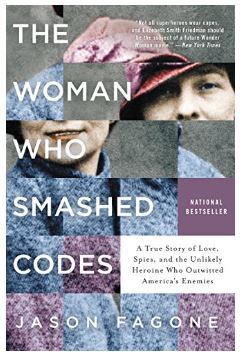
To do battle against rumrunners and then ferret out Nazis, Elizebeth Friedman and her husband William invented the modern science of cryptology, described in a lively and highly readable saga, The Woman Who Smashed Codes by Jason Fagone.
It Started with Rum
Elizebeth Friedman started using her talents to catch gangsters and smugglers during Prohibition by solving 12,000 rum messages "which covered activities up the Pacific coast …along the Gulf Coast to Tampa; from Key West to Savannah, including Havana, and the Bahamas; and from New Jersey to Maine. Until 1930, she did almost all code breaking for the US government's planetary war against smuggling."[i]
Extracting Intelligence From the New Technology: Radio
"As good as she was at solving the individual messages, Elizebeth's ambition didn't stop there. She wanted to build a broader, more comprehensive system for extracting intelligence from wireless messages, a system that didn't exist at Treasury or anywhere else in the US government because radio was still such a young technology. [To do so,] she sketched maps of the naval routes and maps of the radio traffic [of the smugglers.] She helped train G-men to use direction finding machines that they loaded in the back of pick-up trucks, driving up and down the coast to find hidden pirate radio stations used by the rumrunners. The smugglers essentially acted like foreign spies in wartime, treating intelligence by radio from hostile territories, and to read their thoughts, Elizebeth had to act like a spy hunter, a counterespionage or counterintelligence agent – skills she would ply against the Nazis in the early 1940s."[ii]
Fighting Fascism in South America
Elizebeth "then accepted a covert mission to discover and expose Nazi spy rings that were spreading like wildfire across South America, advancing ever closer to the United States." (The book's details of the plans by fascists in South America surprised me. It's easy to forget that it was a global war, not just a European and Asian one.)
Taking on Hitler's Machine
As World War II raged, Elizebeth fought a highly classified battle of wits against Hitler's Reich using 4,000 typed decryptions of secret Nazi messages that her team shared with the global intelligence community. She had conquered at least 48 different clandestine radio circuits and three Enigma machines to get these. The pages found their way to the Navy and to the Army. To FBI headquarters in Washington and bureaus around the world. To Britain. These pieces of paper saved lives. They almost certainly stopped coups. They put fascist spies in prison. They drove wedges between Germany and other nations that were trying to sustain and prolong Nazi terror."[iii]
Meanwhile, inside an Army vault in Washington, [her husband] William worked furiously to break Purple, the Japanese version of Enigma--and eventually succeeded, at a terrible cost to his personal life and mental health.
"For the first eight months of the war, as incredible as it sounds, William and Elizebeth and their team did all of the code breaking for every part of the US government: for the State Department, the War Department, the Navy, and the Department of Justice."[iv] Their success led the British government to request a closer connection between their Bletchley Park decoders and her team.
"By any measure Elizebeth was a great heroine of the Second World War" though she was bound by oath to keep her work secret and was unable to discuss it, even long after the war. J. Edgar Hoover, however, took no such oath and he blatantly claimed her accomplishments for the FBI, even though the documents carried the stamp of her department.
True to its cover copy, "Fagone unveils America's code-breaking history through the prism of Elizebeth's life, bringing into focus the unforgettable events and colorful personalities that would help shape modern intelligence."
[i] The Woman Who Smashed Codes, Jason Fagone, Dey Street Books, 2017, Part two, page 415
[ii] op. cit., part two, page 409
[iii] op. cit., chapter 5 page 446
[iv] op. cit., chapter 4, page 259.